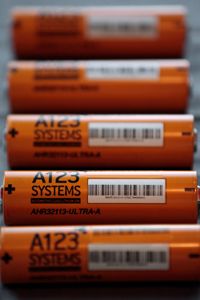Hybrid Car Manufacturing
Despite their increased fuel efficiency and potential for eco-friendly, green driving, hybrid vehicles are manufactured in much the same way other cars are. As with the build process of most cars, the typical hybrid is put together on an assembly line according to a carefully choreographed series of steps. Conveyor belts shuttle the parts along and elevators move parts into place. Both human workers and machines are involved in the process.
The main difference in the creation of these fuel-efficient vehicles is in the batteries. Hybrid batteries are large, rechargeable and take up a considerable amount of space. They're made by specialty battery companies, like Panasonic and Sanyo, chiefly located in Japan. Hybrids use nickel metal hydride (NiMH) batteries orlithium-ion (Li-ion) batteries.
Advertisement
To make a lithium-ion battery, a lithium ingot is extruded under pressure into a sheet that's just .01 inches (0.254 millimeters) wide. Machinery is then used to wind these sheets into tightly coiled cells. These wound-up sheets are baked at a high temperature and molten metal is sprayed onto the sheets by automated equipment — a process known as metalizing. Several metalized battery cells are then stacked together in a module.
There are certain misconceptions about hybrid car manufacturing. One is that the amount of carbon dioxide released in the manufacture of a hybrid car, such as the Toyota Prius, is greater than the amount saved by driving one. Many experts have debunked this idea, yet it persists [source: Gratton]. According to Toyota's own figures, a Prius only has to be driven for about 13,000 miles (20,921 kilometers) for the CO2 savings to outweigh the manufacturing costs. It has also been suggested that the sheer distance the nickel used in the manufacture of the Prius' NiMH batteries travels before it reaches the factory causes more energy to be burned than would be burned by driving a Hummer instead of a Prius. However, analysts have shown that this idea is based on faulty assumptions. The Prius saves more energy than the manufacturing process uses.
For more information about hybrid cars and other related topics, follow the links below.
Related HowStuffWorks Articles
Sources
- Berman, Bradley. "When Old Things Turn Into New Again." The New York Times. Oct. 24, 2007. (Sept. 2, 2009) http://www.nytimes.com/2007/10/24/automobiles/autospecial/24history.html
- Gratton, Ken. "Toyota Prius: Toyota answers hybrid skeptics." CarPoint Australia. July 14, 2009. (Sept. 2, 2009) http://www.carpoint.com.au/news/2009/small-passenger/toyota/prius/toyota-prius- toyota-answers-hybrid-sceptics-15838
- Historyofhybridcars.com. "History Of Hybrid Cars." (Sept. 2, 2009) http://www.historyofhybridcars.com/
- Hybrid Car Review. "Woods Dual Power - Hybrid Car of 1917." April 20, 2006. (Sept. 2, 2009) http://hybridreview.blogspot.com/2006/04/woods-dual-power-hybrid-car-of-1917.html
- Hybridvehicle.org. "Hybrid Vehicle History - More than a Century of Evolution and Refinement." (Sept. 2, 2009) http://www.hybrid-vehicle.org/hybrid-vehicle-history.html
- Hybrid Cars. "The Hybrid Car Battery: A Definitive Guide." Nov. 6, 2008. (Sept. 2, 2009) http://www.hybridcars.com/hybrid-car-battery
- Kanellos, Michael. "Inside Toyota's hybrid factory." CNET News. Oct.10, 2006. (Sept.2, 2009) http://news.cnet.com/Inside-Toyotas-hybrid-factory/2100-11389_3-6124334.html
- Sherman, Don. "A History of Hybrid Vehicles." Automobile Magazine. Dec. 31, 2007. (Sept. 2, 2009) http://www.automobilemag.com/features/0712_hybrid_history/index.html
- Simply Hybrid. "The 100 Year History Of The Hybrid Car." (Sept. 2, 2009) https://www.simplyhybrid.com/hybrid-vehicle-articles/hybrid-auto-history.php
- The Tech FAQ. "What is the History of Hybrid Cars?" (Sept. 2, 2009) http://www.tech-faq.com/history-of-hybrid-cars.shtml
